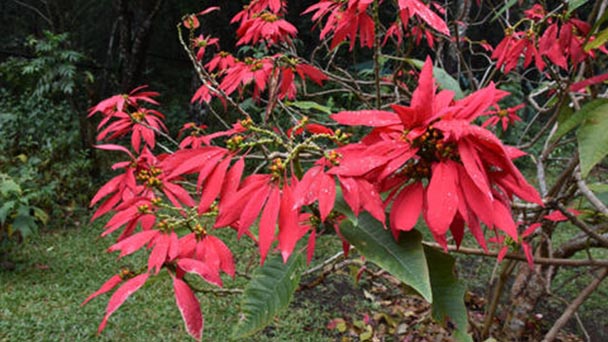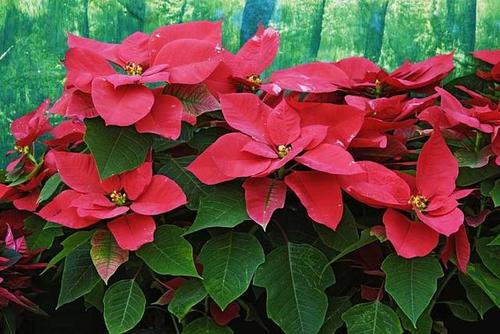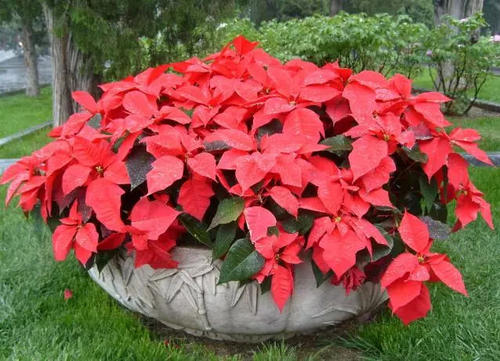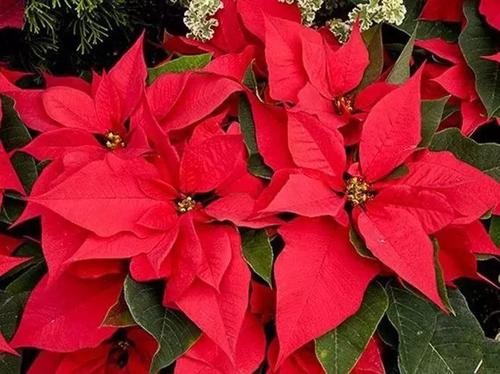Poinsettia profile
Written by Maggie
Jan 26 2021

Poinsettia, scientific name Euphorbia pulcherrima Willd, is a kind of Euphorbiaceae plant, also known as Christmas flower, used to decorate Christmas with red flowers. Any of several colorless leaf-viewing plants native to the Tusco region of Mexico.
Poinsettia picture

Poinsettia characteristics
Poinsettia (Euphorbia pulcherrima Willd) are evergreen shrubs, 50 -- 300 cm tall, with white milky stems and leaves. Smooth stem, green shoots, dark brown older branches.
Poinsettia (Euphorbia pulcherrima Willd) is alternate; Cupliform cymes, each inflorescence has only 1 stamen and 1 pistil, under which a bright red involucre is formed, leaf shape, gorgeous color, is the main part of the ornamental. The Poinsettia's flowers are made up of leaf-like, brightly colored bracts (" twisted leaves "), with the real flowers being a cluster of tiny yellow-green flowers in the middle.
Poinsettia (Euphorbia pulcherrima Willd) is a capsule fruit. The fruit matures from September to October, and the flowering period is from December to March of the next year. Ovate-elliptic, entire or undulate lobed, sometimes viola-shaped, apical leaf blade narrower, lanceolate; Leaves of Poinsettia are hairy, thin leaf texture, veins obvious; The leaves near the top of the inflorescence are bracts, and the Poinsettia are red when flowering. Inflorescences are cup-shaped cymose arrangement, terminal; Involucre is pale green, margin with teeth and 1 to 2 large yellow glands; Male flowers of Poinsettia are petiolate, perianth absent; Female flowers are solitary, central involucre; Natural flowering period of Poinsettia is in winter. There are white and pink cultivars.
Poinsettia (Euphorbia pulcherrima Willd) is a terete root with very many branches.Stems erect, 1-3 (4) m tall, 1-4 (5) cm in diameter, glabrous. Leaves are alternate, ovate-elliptic, oblong-elliptic, or lanceolate, 6-25 cm long, 4-10 cm wide, apex acuminate or acute, base cuneate or attenuate, green, margin entire or lobed or undulate lobed, face pubescent or glabrous, back of leaves pubescent; Petiole of Poinsettia is 2-5 cm long, glabrous;Without stipule; Poinsettia has 5-7 bracts, narrowly elliptic, 3 -- 7 cm long, 1 -- 2 cm wide, usually entire, margin rarely shallowly undulate, vermilion; Petiole is 2-6 cm long.
The Poinsettia (Euphorbia pulcherrima Willd) is a number of cymbals arranged on the top of the branch; Pedicle is 3 -- 4 mm long; Involucral bracts are altar-shaped, pale green, 7 -- 9 mm tall, 6 -- 8 mm in diam., margin dentate 5-lobed, lobes triangular, glabrous; Poinsettia has 1 gland, rarely 2, yellow, normally compressed, two-lipped, 4-5 mm long, about 3 mm wide. Male flowers of Poinsettia are numerous, often protruding outside the involucre; Bracts are filiform, pilose; Poinsettia has 1 female flowers, ovary stalks distinctly protruding beyond involucre, glabrous; Ovary is smooth; Style 3, connate below middle; Stigma is 2-lobed. Capsule, triangulate, 1.5-2.0 cm long, ca. 1.5 cm in diameter, smooth, glabrous. Seeds of Poinsettia are ovate, ca. 1 cm long, 8-9 mm in diam., gray or grayish, sub smooth.
Poinsettia growth habit
Poinsettia (Euphorbia pulcherrima Willd) is a short-day plant, which likes to be warm, and the suitable temperature for growth is 18-25℃, 18-24℃ from spring to autumn, 13-16℃ from autumn to spring of the next year, and the temperature in winter is not less than 10℃. Poinsettia is sensitive to water, as long as the water supply is sufficient during the growing period. Poinsettia is pleasant to sunshine, in the stem and leaves growth period need sufficient sunshine, promote the stem and leaves to grow rapidly and luxuriant.

Poinsettia distribution area
Poinsettia (Euphorbia pulcherrima Willd) is distributed in central America, widely cultivated in the tropics and subtropics. Most provinces and cities in China are cultivated, common in parks, botanical gardens and greenhouses, for viewing.
Poinsettia's growing methods
Location and temperature
Plant Poinsettia (Euphorbia pulcherrima Willd) in a warm, bright spot for most of the day, and keep them as far away from the heat holes as possible. Poinsettia prefers to keep the temperature between 10 and 25 degrees, and never let them fall below 10 degrees, which can kill them.
The light
Planting Poinsettia (Euphorbia pulcherrima Willd) requires plenty of bright light, at least six hours a day, but they really don't like direct sunlight, so don't put them near the south window.
Watering
Poinsettia (Euphorbia pulcherrima Willd) is a tropical native and we need to wait until the top of the soil is dry before watering it. The best way to water Poinsettia is to start from the basin, drop it in a few inches of water, let it soak in as much as possible for about an hour, and then let the plants drain for about 30 minutes.
Poinsettia medicinal value
Poinsettia (Euphorbia pulcherrima Willd) is cool and bitter in taste. It has functions of regulating menstruation and hemostasis, promoting blood circulation and resolving phlegm, and relieving bone swelling.

Latest Updated
- Benefits of Bugleweed - 7 Science-backed Health Benefits
- Bugleweed Dangers & Side Effects - Is It Poisonous?
- How to Plant Evergreen Trees - What You Should Know
- When to Plant Evergreens - Grow Guide for Evergreen Trees
- 12 Wonderful Evergreen Shrubs for Your Garden
- 12 Popular Evergreen Plants with Pictures for Beginners
- When And How To Prune A Lilac Bush Like a Pro
- How to Grow & Care for Lilac Vine (Hardenbergia Violacea)
- Japanese Lilac Tree (Syringa Reticulata) Care & Propagation Guide
- Shumard Oak Pros and Cons - What to Know
Popular Articles
- Winter maintenance of Antirrhinum Majus
- How to Grow Terminalia Mantaly Tree
- How to Grow and Care for Crossostephium Chinense
- How to grow Antirrhinum Majus in spring
- Peristeria Elata (Dove Orchid) Profile: Info & Care Guide
- Underwatered Snake Plant (Sansevieria Trifasciata) - Signs And How To Fix
- How to Care for Brazilian Jasmine Plant (Mandevilla Sanderi)
- How to Grow & Care for Graptopetalum Purple Delight in Summer
- Rosa Chinensis (China Rose): Plant Growing & Care Tips
- How to Care for Baby Sun Rose (Aptenia Cordifolia)